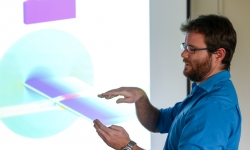A CSIR-developed tool to solve problems related to fluid-structure-interactions
With more computational resources at the disposal of researchers, multi-physics simulations are becoming a reality. Fluid-structure interactions (FSI), a subclass of multi-physics problems is gaining in popularity. FSI can broadly be defined as the multi-field simulation or modelling of the interaction between fluid flow and deformable structures. Most of these problems are two-way coupled, where fluid flow induces deformations on the structure, which in turn influences the fluid domain velocities and internal stress states.
An easily understandable example of FSI is blood flow through the cardio-vascular system. A pressure pulse from the heart causes artery walls to expand ever so slightly. This arterial-wall expansion in turn causes a pressure pulse to propagate through the arterial system at enormous speeds (up to 500cm/s) which in turn slowly forces blood to circulate through the body (at velocities below 40cm/s). The very nature of blood flow is a strongly coupled problem between fluid flow and arterial wall deformations. The flow of blood is directly dependent on the arterial wall displacements, where these displacements are again a direct result of the interacting blood flow. To solve problems of this nature requires accounting for the highly non-linear, strongly coupled interactions between multiple physical domains.
A CSIR-developed coupling tool enables the solution of these types of problems by coupling two or more stand-alone, sub-domain, field-specific solvers. To allow for the simulation of blood flow, a fluid dynamics software package such as Fluent or OpenFOAM can be coupled with a structural dynamics software package like Abaqus or Calculix. The coupling technology is a black-box coupler, which requires no access or modifications to the source code of either of the pre-existing independent sub-domain solvers. The black-box coupling tool therefore enables multi-physics simulations by allowing researchers to re-use, as is, the software packages they already have at their disposal.
There are however many well-known, limiting issues when treating multi-physics problems via black-box coupling methods. To circumvent these limiting issues, a host of novel numerical methods have been developed resulting in a reliable, robust and efficient coupling environment. The coupling tool has enormous potential for engineers and researchers alike.




